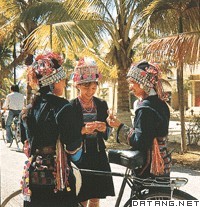2) Manmo Ha ni village


曼么哈尼族村寨
1.
Manmo Ha ni village was used as an example to discuss the developmentof village eec-tourism.
以曼么哈尼族村寨为例。
3) Qingkou Hani nationality village


箐口哈尼族村寨
4) Dong Minority village


侗族村寨
1.
Zuolong Village is a typical Dong Minority village that maintains many original eco-cultures and possesses relatively unabridged spatial structure.
座龙寨是一个保持较多原生态文化、空间结构较完整的典型侗族村寨。
2.
The tradition architectural construction art of Dong minority village is one of the rare treasures and beautiful flowers in the chinese nation architectural culture.
侗族村寨传统建筑风格是中华民族建筑文化的奇葩瑰宝。
3.
The Dong minority village settlement shape\'s formation is products by many factor combined action such as history,society,culture and so on,is result to the natural environment positive adaptation.
侗族村寨聚落形态的形成是历史、社会、文化等因素共同作用的产物,是对自然环境积极适应的结果。
5) Ethnic village


民族村寨
1.
CCTV:A mode of the development of ethnic village ——Taking Mengjinglai Village of Xishuangbanna An Example;
民族村寨旅游开发的CCTV模式———以西双版纳“中缅第一寨”勐景来为例
2.
The construction of index system for the community-involved sustainable tourism development on ethnic village——Taking the Langde Village in Guizhou as examples
社区参与视角下的民族村寨旅游可持续发展指标体系构建——以贵州省雷山县上郎德苗寨为例
3.
As a kind of special community, ethnic village is an important area of rural tourism development in China.
民族村寨作为一类特殊社区,是我国乡村旅游开发的重要区域。
6) Ethnic Villages


民族村寨
1.
Study on the Development of Tourism Landscape System in Ethnic Villages——Taking Da Binglang Dai Nationality Village in Yunnan Province as an Example;
民族村寨旅游景观系统的开发研究——以云南大槟榔花腰傣村寨为例
2.
ethnic villages are the main carrier of resources of ethnic cultural tourism.


民族村寨是民族文化旅游资源的主要载体。
3.
On the basis of the fieldwork inthe ethnic villages of China by Yunnan University, this paper describes the distinguishing stagesof the economic transition of Chinese ethnic villages and gives a preliminary analysis for its structure and dynamicalcharacteristics.
本文据云南大学中国少数民族村寨调查资料 ,对中国民族村寨的经济转型做了历史阶段性的划分 ,并对其结构和动力特征进行了初步的分析 ,提出资源约束的强制性在中国民族村寨的经济转型中日益突出 ,经济转型关联到生活方式的改变 ,动力差异产生了整体性的突发转型和个体选择性的渐变转型两种基本类型。
补充资料:哈尼族
| 哈尼族 中国少数民族 。主要分布在云南省西南部礼社江下游红河西侧哀牢山区。人口125.4万(1990)。使用哈尼语,属汉藏语系藏缅语族彝语支。原无文字,1957年创制了以拉丁字母为基础的文字。 哈尼族与彝族可能同源于古羌人中逐渐南迁的一支。公元7世纪已居住于今哀牢山、无量山一带。南诏时,其分布区域与今哈尼族在红河外侧聚居区大体相同。在这一地区,元设和泥路,明初改为和泥府;后又分设纳楼、溪处、思陀、左能、落恐等长官司,隶临安府。以各部落首领任土官。哈尼族社会发展不平衡,中华人民共和国建立前,邻近汉族地区已进入封建领主制地主经济也有所发展;接近傣族的地区,则受傣族封建领主统治;个别地区还残存一定的原始农村公社土地所有制特点。哈尼族主要从事农业,善辟梯田种稻谷,掘坡地植茶林。家庭基本上是一夫一妻制,青年男女婚前社交自由。人死行土葬。仍保留有古羌戎父子联名制的传统。民间文学以创世史诗《奥色密色》为代表作。传统节日有十月节、六月节、春节、端午节、中秋节。信仰多神崇拜和祖先崇拜。一般喜欢用自己染织的藏青色土布做衣服。男子穿对襟上衣和长裤,用黑布或白布裹头。妇女多穿右襟无领上衣和长裤,胸前挂成串的银饰,头戴镶有小银泡的圆帽,带耳环、耳坠和大手镯。
|
说明:补充资料仅用于学习参考,请勿用于其它任何用途。
参考词条
